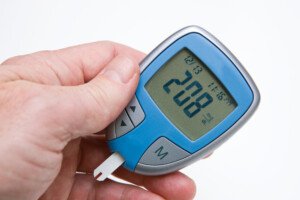
Here are 10 things an insulin dependent bodybuilder with diabetes should never do.
If you want to build your best muscle and not worry about your blood sugar levels, here is your training guide.
“These are my top 10 ‘don’t do’ tips for bodybuilders with insulin dependent diabetes,” says Christel Oerum, a type 1 diabetic and ISSA-certified personal trainer with specialization in diabetes.
“Assuming all kinds of exercise impacts blood sugars in the same way.”
Oerum adds, “Most people will see a dip in blood glucose when doing cardio and an increase when doing anaerobic [bodybuilding] exercise. By learning how you react, you can proactively manage your blood sugars.”
“Allowing your blood sugars to run high all the time (to avoid lows or to drop weight fast).”

Shutterstock/Hdc Photo
Oerum points out that “diabetes is a catabolic (muscle wasting) disease if poorly controlled, so keeping your blood sugars within range is crucial, not just for general health, but also for muscle building and conservation.”
“Thinking you need to eat a ‘diabetic’ diet.”
Oerum does not believe in the so-called diabetic diet. Instead, she explains that “you should eat healthily and for your goals.

“As a bodybuilder, that means lots of lean protein, healthy fats and carbs. Stick with low/medium glycemic carbs to avoid blood sugar spikes unless it’s right after a workout.”
“Not taking the time to find your individual formula.”
Oerum explains, “If you don’t understand how different kinds of exercise and food impact you, you’ll end up chasing your blood sugars, and staying in range will become increasingly difficult. Track your food, insulin and exercise and look for patterns.”
“Not understanding how different foods affect your blood sugar.”
Every bodybuilder is different in that they don’t metabolize food identically. “For example, oats are great for some people but wreak havoc on the blood sugar for others.
“So experiment and learn how your body responds to different foods from a diabetes management perspective.”
“Not taking time to recover from a severe low blood sugar.”
After an episode of severe hypoglycemia (blood sugar plunge low enough that assistance from another individual was required), the type 1 (insulin dependent) diabetic should not exercise for 24 hours.
“Caution should also be shown 24 hours after a self-treated episode of hypoglycemia, since previous episodes of hypoglycemia will increase the likelihood of new episodes.”
“Not getting your medical checkup.”
Unfortunately, if the insulin dependent diabetic has certain complications such as retinopathy, bodybuilding is not a good idea, as this can further the damage.
“You don’t know what you don’t know, so get your annual checkup before starting a bodybuilding routine.”
“Exercising with blood sugars that are too high.”
Oerum explains that if glucose is above 270 mg/dL, a few precautions are in order per the January 23, 2017 consensus statement in Lancet Diabetes Endocrinol:
1. Check blood ketones and perform low-intensity exercise, or give a small corrective dose of insulin.
2. Low-intensity exercise may be okay if blood ketones are below 27 mg/dL (or below 2+ urine ketones). Consider taking a small corrective dose of insulin.
“Thinking that taking insulin will give you an ‘edge’ as a bodybuilder.”
Oerum says, “Deficiencies in insulin production and/or poor insulin sensitivity will result in an impairment of the body’s ability to process glucose and build muscle.
“And with good glucose control, all you do is re-establish the body’s natural muscle building abilities.”
“Not learning from your diabetes community.”
There is a strong online community of bodybuilding enthusiasts with insulin dependent diabetes, says Oerem. “Learn from your peers — there’s no need to reinvent the wheel.”
 Christel Oerum writes about how to be fit with diabetes on TheFitBlog, training people with diabetes from across the globe, online and in person.
Christel Oerum writes about how to be fit with diabetes on TheFitBlog, training people with diabetes from across the globe, online and in person.
 Lorra Garrick is a former personal trainer certified through the American Council on Exercise. At Bally Total Fitness she trained women and men of all ages for fat loss, muscle building, fitness and improved health.
Lorra Garrick is a former personal trainer certified through the American Council on Exercise. At Bally Total Fitness she trained women and men of all ages for fat loss, muscle building, fitness and improved health.
.









































